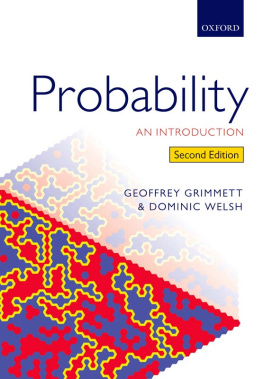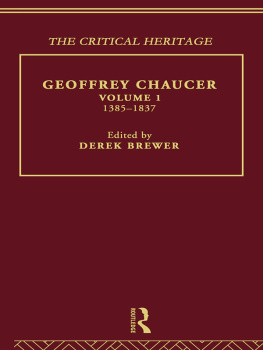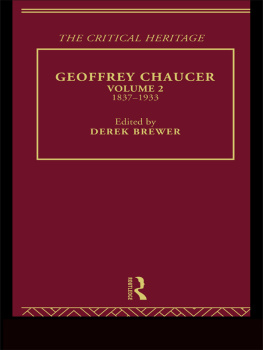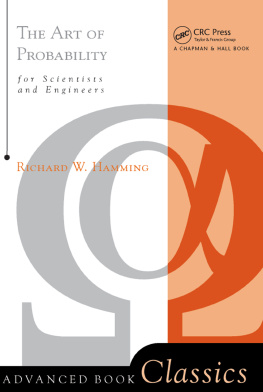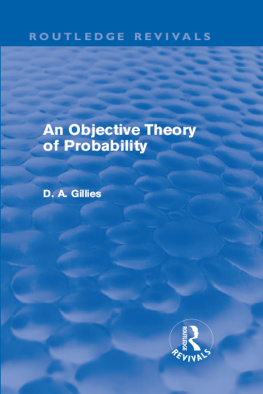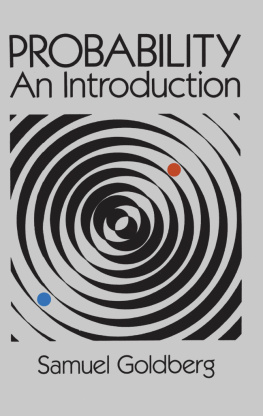Grimmett Geoffrey - Probability
Here you can read online Grimmett Geoffrey - Probability full text of the book (entire story) in english for free. Download pdf and epub, get meaning, cover and reviews about this ebook. year: 2014, publisher: Oxford University Press, Incorporated, genre: Romance novel. Description of the work, (preface) as well as reviews are available. Best literature library LitArk.com created for fans of good reading and offers a wide selection of genres:
Romance novel
Science fiction
Adventure
Detective
Science
History
Home and family
Prose
Art
Politics
Computer
Non-fiction
Religion
Business
Children
Humor
Choose a favorite category and find really read worthwhile books. Enjoy immersion in the world of imagination, feel the emotions of the characters or learn something new for yourself, make an fascinating discovery.
- Book:Probability
- Author:
- Publisher:Oxford University Press, Incorporated
- Genre:
- Year:2014
- Rating:3 / 5
- Favourites:Add to favourites
- Your mark:
- 60
- 1
- 2
- 3
- 4
- 5
Probability: summary, description and annotation
We offer to read an annotation, description, summary or preface (depends on what the author of the book "Probability" wrote himself). If you haven't found the necessary information about the book — write in the comments, we will try to find it.
Probability — read online for free the complete book (whole text) full work
Below is the text of the book, divided by pages. System saving the place of the last page read, allows you to conveniently read the book "Probability" online for free, without having to search again every time where you left off. Put a bookmark, and you can go to the page where you finished reading at any time.
Font size:
Interval:
Bookmark:

Probability
An Introduction

Great Clarendon Street, Oxford, OX2 6DP,
United Kingdom
Oxford University Press is a department of the University of Oxford.
It furthers the Universitys objective of excellence in research, scholarship, and education by publishing worldwide. Oxford is a registered trade mark of Oxford University Press in the UK and in certain other countries
Geoffrey Grimmett & Dominic Welsh 2014
The moral rights of the authors have been asserted
First Edition published in 1986
Second Edition published in 2014
Impression: 1
All rights reserved. No part of this publication may be reproduced, stored in a retrieval system, or transmitted, in any form or by any means, without the prior permission in writing of Oxford University Press, or as expressly permitted by law, by licence or under terms agreed with the appropriate reprographics rights organization. Enquiries concerning reproduction outside the scope of the above should be sent to the Rights Department, Oxford University Press, at the address above
You must not circulate this work in any other form and you must impose this same condition on any acquirer
Published in the United States of America by Oxford University Press
198 Madison Avenue, New York, NY 10016, United States of America
British Library Cataloguing in Publication Data
Data available
Library of Congress Control Number: 2014938231
ISBN 9780198709961 (hbk.)
ISBN 9780191019937 (ebook)
Printed and bound by
CPI Group (UK) Ltd, Croydon, CR0 4YY
Preface to the second edition
Probability theory is now fully established as a crossroads discipline in mathematical science. Its connections across pure and applied mathematics are in excellent health. In its role as the science of risk, it is a lynchpin of political, economic, and social science. Never before have so many students in schools and universities been exposed to the basics of probability. This introductory text on probability is designed for first and second year mathematics students. It is based upon courses given at the Universities of Bristol, Cambridge, and Oxford.
Broadly speaking, we cover the usual material, but we hope that our account will have certain special attractions for the reader and we shall say what these may be in a moment. The first eight chapters form a course in basic probability, being an account of events, random variables, and distributionswe treat discrete and continuous random variables separatelytogether with simple versions of the law of large numbers and the central limit theorem. There is an account of moment generating functions and their applications. The next three chapters are about branching processes, random walks, and continuous-time random processes such as the Poisson process. We hope that these chapters are adequate at this level and are suitable appetizers for further courses in applied probability and random processes. The final chapter is devoted to Markov chains in discrete time.
As in the first edition, this text is divided into three sections: (A) Probability, (B) Further Probability, and (C) Random Processes. We hope thus to indicate two things. First, the probability in Part A seems to us to be core material for first-year students, whereas the material in Part B is somewhat more difficult. Secondly, although random processes are collected together in the final four chapters, they may well be introduced much earlier in the course. The chapters on branching processes and random walks might be studied after . The chapter on Markov chains can in addition be used as the basis for a free-standing 1216 lecture course.
The major difference of substance between the first and second editions of this text is the new on Markov chains. This chapter is a self-contained account of discrete-time chains, culminating in a proper account of the convergence theorem. Numerous lesser changes and additions have been made to the text in response to the evolution of course syllabuses and of our perceptions of the needs of readers. These include more explicit accounts of geometrical probability, indicator functions, the Markov and Jensen inequalities, the multivariate normal distribution, and Cramrs large deviation theorem, together with further exercises and problems often taken from recent examination papers at our home universities.
We have two major aims: to be concise, and to be honest about mathematical rigour. Some will say that this book reads like a set of lecture notes. We would not regard this as entirely unfair; indeed a principal reason for writing it was that we believe that most students benefit more from possessing a compact account of the subject in 250 printed pages or so (at a suitable price) than a diffuse account of 400 or more pages. Most undergraduates learn probability theory by attending lectures, at which they may take copious and occasionally incorrect notes; they may also attend tutorials and classes. Few are they who learn probability in private by relying on a textbook as the sole or principal source of inspiration and learning. Although some will say that this book is quite difficult, it is the case that first-year students at many universities learn some quite difficult things, such as axiomatic systems in algebra and / analysis, and we doubt if the material covered here is inherently more challenging than these. Also, lecturers and tutors have certain advantages over authorsthey have the power to hear and speak to their audiencesand these advantages should help them explain the harder things to their students.
Here are a few words about our approach to rigour. It is impossible to prove everything with complete rigour at this level. On the other hand, we believe it is important that students should understand why rigour is necessary. We try to be rigorous where possible, and elsewhere we go to some lengths to point out how and where we skate on thin ice.
Most sections finish with a few exercises; these are usually completely routine, and students should do them as a matter of course. Each chapter finishes with a collection of problems; these are often much harder than the exercises, and include numerous questions taken from examination papers set in Cambridge and Oxford. We acknowledge permission from Oxford University Press in this regard, and also from the Faculties of Mathematics at Cambridge and Oxford for further questions added in this second edition. There are two useful appendices, followed by a final section containing some hints for solving the problems. Problems marked with an asterisk may be more difficult.
We hope that the remaining mistakes and misprints are not held against us too much, and that they do not pose overmuch of a hazard to the reader. Only with the kind help of our students have we reduced them to the present level.
Finally, we extend our appreciation to our many students in Bristol, Oxford, and Cambridge for their attention, intelligence, and criticisms during our many years of teaching probability to undergraduates.
GG, DW
Cambridge, Oxford
February 2014
Summary. The very basic principles and tools of probability theory are set out. An event involving randomness may be described in mathematical terms as a probability space. Following an account of the properties of probability spaces, the concept of conditional probability is explained, and also that of the independence of events. There are many worked examples of calculations of probabilities.
Many actions have outcomes which are largely unpredictable in advancetossing a coin and throwing a dart are simple examples. Probability theory is about such actions and their consequences. The mathematical theory starts with the idea of an
Font size:
Interval:
Bookmark:
Similar books «Probability»
Look at similar books to Probability. We have selected literature similar in name and meaning in the hope of providing readers with more options to find new, interesting, not yet read works.
Discussion, reviews of the book Probability and just readers' own opinions. Leave your comments, write what you think about the work, its meaning or the main characters. Specify what exactly you liked and what you didn't like, and why you think so.

